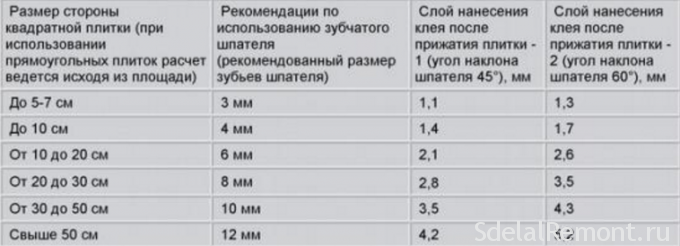In wall covering using ceramic materials important factor is the thickness of the adhesive for laying tiles. That is why, one of the main tasks is its correct calculation. This takes into account factors of weight, including the type of material, dimensions, quality of the base, etc.. It is about, how to take into account these factors, as well as any required thickness of the tile laying we'll talk.
Types of adhesive and its features
First we need to deal with features of adhesive mixtures. Although a large role and plays directly to the material itself, which is planned to be laid, but at the same time, the glue appearance is just as important.
In total, can be identified in all three types of adhesive mixtures, namely:
- grout. This mixture was used in most cases. In its composition it has a cement, sand and additional modifier compositions. This adhesive is simple and easy to use, precisely because the most common.
- Second in a row, you can select two-component adhesive. For the most part these include epoxies, which imply a mixture of epoxy resin and catalyst. Such a mixture can provide sufficiently effective grip with the surface of the tile.
- And the latter becomes dispersive. This glue is sold in ready to use form. It is mainly based on the components of the Smolny, in some cases, apply polymeric substances. The most popular composition of this type is the latex adhesive.
Already we can note, the thickness of the tile laying using adhesive cement will be more, than in other cases.
The dependence of the thickness of the glue on various factors
Now consider that the same depends on the thickness of the tile adhesive for laying tiles. It should be noted, that when laying, it may vary, but there are some restrictions. In this case, to obtain a reliable and durable coating, must adhere to certain rules, or rather limits, as a minimum, and maximum.
In particular, speaking on the minimum value, layer can be noted in 2 millimeter, which is used when laying small products. In the same time, for larger tiles becomes minimum threshold layer 4-5 mm. Same, adhesive thickness when laying tiles on the floor can reach up to 12 mm.
Maximum same threshold, whichever, which laid the tiles and how can reach the size of a few centimeters. If we consider a total of, we can see, that the increase in the mixture due to the need to align the coating. But anyway, if you can not do it with a layer of glue in 10 millimeters for conventional tile, and 2 centimeters for granite, there is already need to carry out the screed or other type of surface alignment.
And so we note, layer that value may vary. Even the most qualified experts can not say with certainty what is necessary thickness, because they work ever adjust to the base and the level of. because, take into account the greater complexity of the necessary minimum and maximum values.
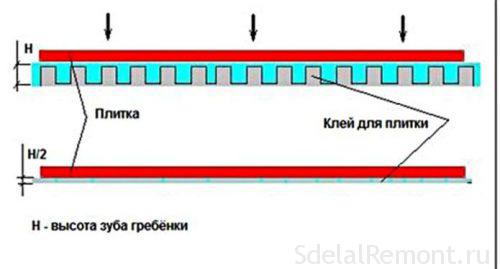
We now consider a little more closely the factors, which affect the thickness of tiling the floor or wall. Let's start.
Dependence on the size of the tile
first, what determines the adhesive layer for laying tiles size of the material becomes. In this way, depending on the tile size It depends on its weight, in the same time, the load on the surface and adhesive thickness is calculated. In this way, specialists already calculated required thickness based on years of experience ( in some cases, of course, Do make small changes). When using a synthetic adhesive layer will be on the 1-2 less than a millimeter, when the cement mixture, respectively - more.
- With the size of the tiles 5 to 10 centimeters - 2-3 mm.
- When the amount in 10-15 centimeters, adhesive layer 3-4 mm.
- 15-20 cm - 4-5 mm.
- 20-25 cm - 5-6 mm.
- 25-30 cm - 6-7 mm.
- from 40 centimeters or more - from 7 and to 10 millimeters.

additional Dependencies
It is also necessary to consider other factors, since the size of the tiles are not the only one among them. For example, at laying porcelain tiles, layer will be greater, than using tiles. Besides, it is important to take into account where the tile is laid, on the floor or on the wall. In this way, the thickness of the adhesive layer for laying tiles on a floor is greater by a few millimeters, than with wall paneling.
Besides, base also directly affects the thickness of the adhesive for tiling. If the substrate is formed on the level of, without the presence of defects, the thickness is invariable. If there are any bulges, holes or other defects, the thickness in some cases it will be necessary to reduce, and sometimes increase. Although, the presence of defects of quality masonry can not walk and talk, because it is desirable to align the, to save power, time and financial costs, since the cost more expensive adhesive mixtures for alignment.
An important factor is the surface of the material and. In some cases, may have distortion granite, ie. convexity or convex in the surface. In such a situation it is necessary to provide the same layer (no more 10 mm) at the extremes, and adjusted to a central edge.
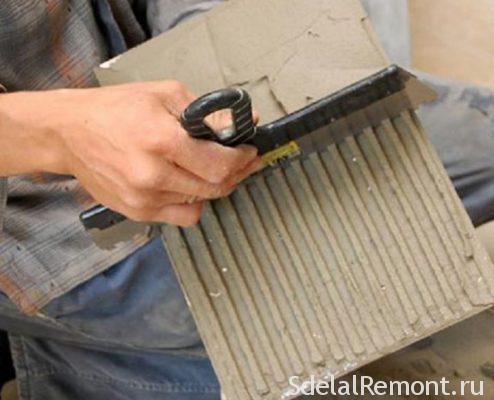
Vlagopogloschaemost and humidity
And here are a few factors, to consider when answering the question which needs a layer of tile adhesive. In particular, it is a solution of humidity, at the base number with the ability to absorb moisture. Given these factors, can say, that when laying ceramic categorically not allowed to use a semi-dry solution, and at the same time, the base must always be primed. When this layer is necessary to do so many, which allows to minimize moisture absorption.
In this case, in the presence of a base at a high level vlagopogloschaemosti it becomes necessary to increase the layer, avoid peeling tiles after drying. And note, that extra moisturizing base is not particularly help, especially, when it comes to plaster.
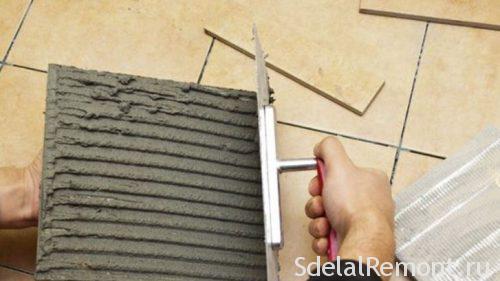
The main mistake many becomes the excellency of hydration. As people pour a lot of water, to avoid such drying out, followed by peeling tiles. And this entails a decrease durability of coatings, since in the presence of excess moisture adhesive mixtures lose their operational characteristics.
Using a notched trowel
For, in order to properly distribute the glue necessary to use special devices (tool). In this case we are talking about a special notched trowel, using which works greatly simplify your work.

There is, which tile thickness with adhesive will depend directly on the value of teeth. When selecting a tool should be considered another factor. Layer thickness is about half the height of the teeth. In this way, by trowel with teeth in 8 millimeters, is applied on the tile adhesive layer 4 mm.
Besides, and take into account the need to, that on the back of the tile has a corrugated pattern, which also comes the solution.
Also, the size of the spatula teeth will depend on the type of adhesive. In this way, for example, for applying glue on the synthetic resin or latex, It will be used in an instrument with teeth 2-4 mm. At the same time, cement glue, this value will be 8 mm and more, depending on the thickness.
Besides, important factor is the, that the adhesive mixture has a minimum coating 80% tile base. It is because the product is applied on the tiles, and on the basis. Wherein, the application must be perpendicular, ie. If the solution applied on the tile horizontally, Based on the need to apply vertical.
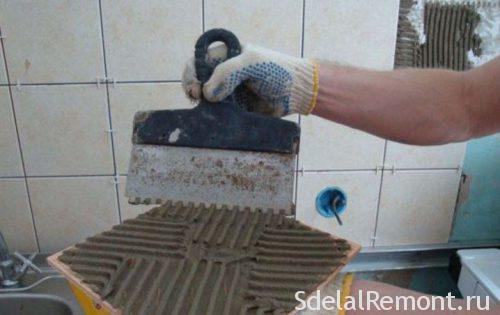
How to calculate the amount of glue?
And the last question, we will continue to analyze the calculation of the amount of required glue mixture. Directly the calculation is carried out in several steps, that we consider:
- The first is to define the size of the material, and selection of the required thickness of the adhesive mixture based on the data presented above. It must also take into account the quality of the base.
- Based on the provided instructions on the adhesive packaging can be found at its layer consumption per square meter 1 millimeters.
- In this way, be multiplied on the layer thickness chosen consumption, on the box. Thus we obtain an intermediate result.
- Followed cladding area to count. After calculations multiply it by the obtained results at the last stage.
- Thus we get the numbers, which shows us the consumption of glue mixture to all premises. But, at the same time keep in mind the possible force majeure, that often occur during installation. For them to be provided at the rate of supply of glue 10-15 percent. Accordingly multiply a number in the past 1,1 or even 1,2.
More than just possible to make calculation of tile adhesive calculator online.
conclusion
Like this, Gradually, we come to the end. And finally we would like to once again stress the importance of proper selection of adhesive thickness. Which it helps to ensure the durability of coatings, increase the strength and to protect the surface from cracks. It is because this issue should be given maximum attention. And in order, to you in more detail to understand the issue, offer to get acquainted with videos on it:

